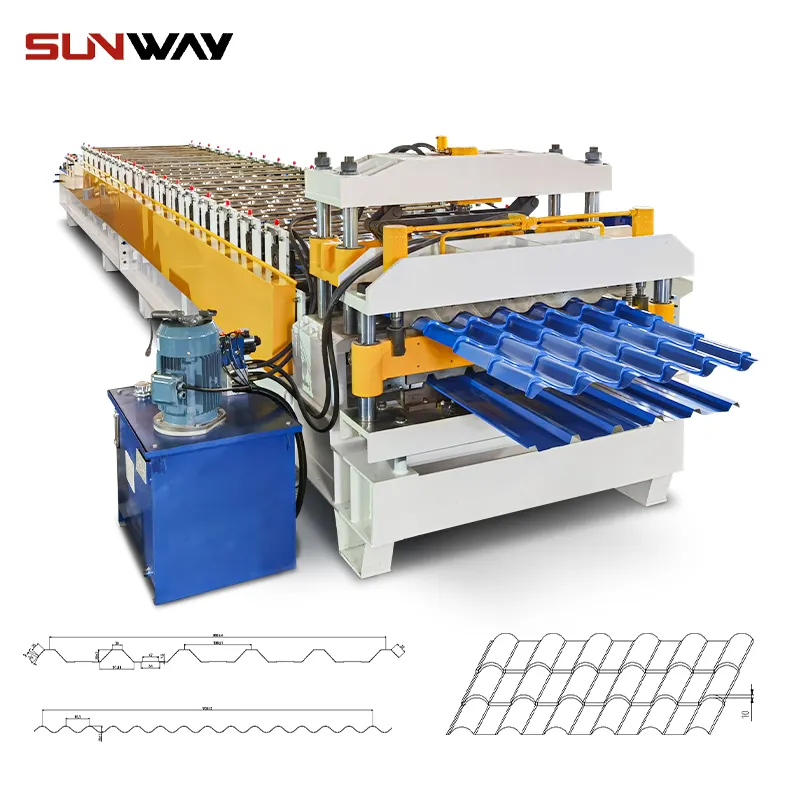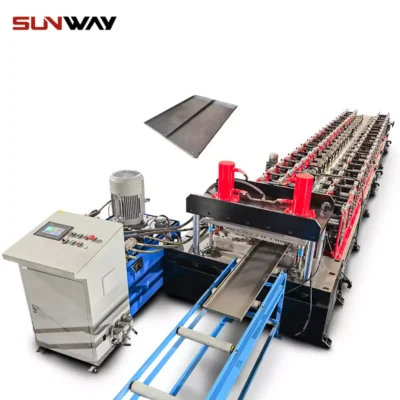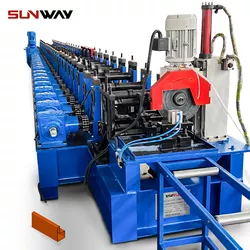Roller shutter slat roll forming machines are used to produce the curved metal slat profiles needed for roller shutter doors and windows. This guide provides detailed information on slat roll former types, workings, specifications, applications, selection, operation, maintenance, and comparisons.
Introduction to Roller Shutter Slat Roll Forming Machines
Roller shutter slat roll forming machines cold form metal coils into the curved profiles used as horizontal louvers in roller shutters and rolling doors. Key features:
- High production speeds up to 40 meters/minute
- Capability to produce different slat shapes and sizes
- Quick and easy size changeover
- Compact and flexible setup
- Consistent quality and close tolerances
- Low operational costs
Roll formed slats are efficient for high volume roller shutter production versus manual methods.

Types of Roller Shutter Slat Roll Forming Machines
Major Types of Slat Roll Forming Machines
- C Shape Slat Roll Former
- Double C Shape Slat Roll Former
- Insulated Slat Roll Former
- Automatic Cutting Slat Roll Former
- Manual Slat Roll Former
- Custom Slat Roll Former
Dedicated machines produce specific slat profiles. Flexible universal roll formers can be switched between multiple shapes and sizes.
Working Principle of Roller Shutter Slat Roll Forming Machines
Slat Roll Forming Process Steps:
- Coil feeding into the roll former
- Sheet passed through progressive roller stations
- Formed into curved slat profile gradually
- Cutting to required length by built-in shear
- Formed slats discharged for collection
It continuously forms metal coils into curved shutter slat profiles.
Key Specifications of Roller Shutter Slat Roll Formers
Technical Specifications:
- Production Speed: 10 – 40 meters/minute
- Forming Width: 80 – 180 mm
- Material Thickness: 0.4 – 1 mm
- Main Drive Power: 1.5 – 4 kW
- Voltage: 220 – 440 V, 3 phase
- Machine Length: 4000 – 8000 mm
- Machine Weight: 1500 – 3000 kg
- Number of Stations: 8 – 16
Specifications depend on required output, material type, and slat dimensions.
Design and Components
Machine Design:
- Robust welded steel frame construction
- Coil holding uncoiler and feeding unit
- Initial sheet guiding system
- Roller stations for bending into slat profile
- Hydraulic shearing system
- Formed slat discharge system
- Electrical controls with automation
Main Components:
- Coil loading and feeding section
- Roll forming stations with guides
- Shearing unit for cutting
- Outfeeding tables for slats
- PLC based controller
- Safety guarding system
Sturdy construction and quality components ensure reliable high-speed production.
Working Principle
Sequence of Slat Roll Forming:
- Coil loaded and fed into the machine
- Sheet pre-bent and passed through progressive stations
- Formed into curved slat profile gradually
- Hydraulic shear cuts slats to length
- Formed slats slide down outfeed tables
- HMI touchscreen automates production
- Sensors monitor operation and halt machine on faults
The cold roll forming action transforms flat metal coil into curved shutter slats.
Raw Material Suitability
Suitable Coil Materials:
- Hot rolled steel
- Cold rolled galvanized steel
- Stainless steel coils
- Aluminum coils
Key Material Parameters:
- Thickness – 0.4 to 1 mm
- Width – 700 to 1250 mm
- Tensile Strength – 280 to 550 MPa
- Coil Weight – Up to 5 tons
Properly specified coils avoid cracking or warping issues.
Customization Options
Customization of Slat Roll Lines:
- Profile dimensions and tolerances
- Quick changeover between sizes
- Special coatings like colors, prints, powder coat
- Hole punching and embossing
- Safety enclosures and lighting
- Integration with upstream/downstream processes
- Touchscreen HMI and data logging
Modular components enable reconfiguration for different profiles, metals and special features.
Applications and End Products
Typical Uses of Roll Formed Slats:
- Shutters for doors, windows, garages
- Counter shutters in retail outlets
- Warehouse and industrial rolling doors
- Security shutters and grilles
- Sliding sun protection shutters
- Slatted outdoor screens and fences
- Rolling covers for trucks, vans, trailers
Roll formed shutter slats provide security, weather protection, privacy, and style across residential, commercial and industrial applications.
Leading Roller Shutter Slat Roll Forming Machine Manufacturers
Notable Slat Roll Former Brands:
- Dahua Machinery (China)
- FU Chun Shin (Taiwan)
- Jouanel Industrie (France)
- Sahinler (Turkey)
- BOTOU Xianfa (China)
- Wonil Machinery (South Korea)
- Metform (Turkey)
- Voestalpine Roll Forming (Austria)
These established brands offer proven and robust slat roll forming machines combining high speeds, quick changeovers, and reliability.
Cost Analysis and Pricing Information
Roller Shutter Slat Roll Former Price Range:
- Basic manual machine – $3,000 to $8,000
- Automatic production line – $15,000 to $50,000
- Large double layer line – $70,000 to $120,000
Pricing depends on production speed, automation level, and width capacity. Installation, training and support add to costs.
How to Select a Suitable Roller Shutter Slat Roll Former
Key Selection Criteria:
- Production speed and daily output targets
- Metal thickness and coil width capacity
- Level of automation required
- Type and variety of slat profiles to be run
- Available installation space and layout
- Power supply requirements and availability
- Budget constraints and ROI goals
- Reputation and experience of machinery supplier
The production targets and space constraints must align with the slat roll former specifications for smooth functioning.
Pros and Cons of Roller Shutter Slat Roll Forming Machines
Advantages of Slat Roll Formers
- High production speeds and volumes
- Consistent and uniform product quality
- Lower scrap rates compared to other processes
- Flexibility to quickly changeover profiles
- Compact footprint requiring less factory space
- Lower labor costs due to automation
Limitations of Slat Roll Formers
- High initial capital expenditure
- Require pre-treatment and flattening of coils
- Skilled personnel needed for operation
- Significant downtime for major size changeovers
- Limited to standard slat profile shapes
- Risk of stoppage if cutting unit fails
- Noisy process requiring sound enclosures
When high volume slat production is needed, the fast output rate and consistency merits investment in roll forming.
Comparison of Roll Forming With Alternatives
Roll Forming vs Other Slat Production Methods
| Factor | Roll Forming | Manual Fabrication | Extrusion |
|---|---|---|---|
| Setup time | Medium | Very High | Low |
| Running costs | Low | High | Medium |
| Labor requirements | Low | High | Medium |
| Production rate | High | Low | Medium |
| Product consistency | Excellent | Poor | Good |
| Shape complexity | Medium | High | Low |
| Tooling cost | Medium | Minimal | Very High |
For rapid production of uniform slats, roll forming is vastly superior on productivity, consistency and costs compared to fabrication or extrusion techniques.

Frequently Asked Questions
Q: What metals can be roll formed into slats?
A: Hot rolled steel, cold rolled galvanized steel, stainless steel and aluminum coils/sheets are commonly used.
Q: What slat thickness is typically used?
A: Standard slat thicknesses range from 0.4 mm to 1 mm. Thicker coils require more powerful roll forming machines.
Q: What maintenance is required for slat roll formers?
A: Mainly cleaning, lubrication, inspection for component wear, and replacement of damaged rollers, cutting blades, etc. as needed.
Q: What safety precautions are mandatory?
A: Proper machine guarding, emergency stops, maintenance during downtime only, and operation by trained personnel wearing protective gear.
Q: How long does it take to changeover between slat sizes?
A: On quick changeover roll formers, size changeover takes only 10-15 minutes in most cases.
Q: How does roll forming compare to extruding slats?
A: Roll forming is faster and cheaper but limited to simple shapes. Extrusion offers complex profiles but has very high tooling costs.







